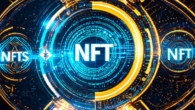
What does the future hold for NFTs
What are NFTs?
At its core, an NFT is a unique digital asset that represents ownership of a particular piece of content. NFTs are stored on blockchain technology, which provides a secure and transparent record of ownership.
Unlike cryptocurrencies, which are interchangeable and fungible, NFTs are non-fungible, meaning they cannot be replaced by another identical asset. NFTs come in various forms, including images, videos, audio files, and even virtual real estate.
They can represent anything of value that can be digitized, making them an attractive option for creators and collectors alike. The unique selling point of NFTs is their ability to provide ownership and authenticity of digital assets, which was previously lacking in the traditional digital world.
The Rise of NFTs

NFTs have gained significant traction in recent years, with several high-profile sales and partnerships driving their adoption. One of the most notable examples is the sale of “Beeple’s Everydays: The First 50 Days of the Year” as an NFT for a record-breaking $69 million at Christie’s auction house in March 2021.
This sale marked the highest price ever paid for a piece of digital art and demonstrated the potential of NFTs as a form of high-value art collectibles.
Another industry where NFTs have gained traction is gaming. NFTs can represent in-game items, such as weapons or characters, providing players with a unique way to own and monetize their digital assets. This has led to the development of new games that incorporate NFTs, such as “Cryptokitties” and “Rarible.”
In addition to art and gaming, NFTs have also found applications in virtual real estate and collectibles. For example, “Decentraland,” a decentralized metaverse platform, allows users to buy and sell virtual land and items using NFTs. Similarly, “OpenSea” is an NFT marketplace that specializes in rare and unique digital assets, such as collectible cards and digital art.
The Future of NFTs
As the adoption of NFTs continues to grow, it’s clear that this technology has immense potential for the future. Here are some key trends and developments that are likely to shape the future of NFTs:
-
Increased adoption by mainstream industries
-
Growth of decentralized finance (DeFi) applications
-
Expansion into new markets
-
Increased regulation and standardization
Conclusion
In conclusion, NFTs are a promising new technology that has already found applications in various industries. As adoption continues to grow, we can expect to see further innovation and expansion into new markets. While there are still challenges to overcome, such as increased regulation and standardization, the potential benefits of NFTs make them an exciting prospect for the future.
FAQs
1. What is the difference between NFTs and cryptocurrencies?
NFTs are unique digital assets that represent ownership of a particular piece of content, while cryptocurrencies are interchangeable and fungible digital currencies.
2. How are NFTs stored?
NFTs are stored on blockchain technology, which provides a secure and transparent record of ownership.
3. What industries are using NFTs?
NFTs have found applications in various industries such as art, gaming, virtual real estate, collectibles, and decentralized finance (DeFi).
4. What is the future of NFTs?
The future of NFTs looks promising, with increased adoption by mainstream industries, growth of DeFi applications, expansion into new markets, and increased regulation and standardization expected to shape the industry in the coming years.







